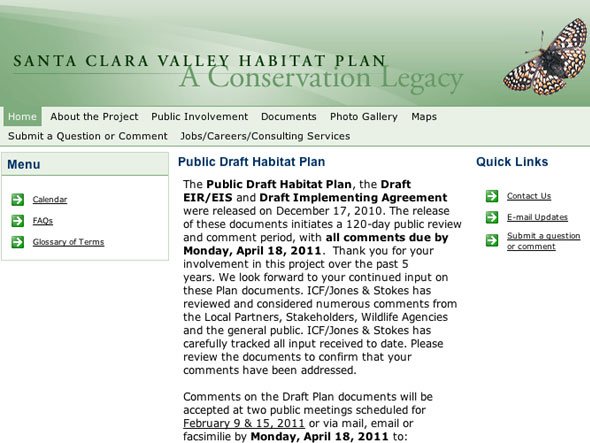Several members of the Gilroy City Council said Monday they
wanted to send a message regarding a county habitat conservation
plan. Their message: Count us out.
Several members of the Gilroy City Council said Monday they wanted to send a message regarding a county habitat conservation plan.
Their message: Count us out.
By a 4-3 margin, the Council voted to opt out of participating in the Santa Clara Valley Habitat Conservation Plan – a sprawling, 50-year plan intended to identify land occupied by endangered or threatened species and streamline the process to obtain permits to build on them.
Council members Bob Dillon, Perry Woodward, Dion Bracco and Mayor Al Pinheiro voted to halt the city’s participation in the plan. Peter Arellano, Cat Tucker and Peter Leroe-Muñoz voted against the motion.
“For all 2,800 pages of it, I couldn’t see any benefit for Gilroy,” Dillon said.
Arellano said the Council should wait to vote on opting out because the final plan had not been brought before them.
The vote came three weeks before the close of a 120-day public comment period for the plan’s draft environmental impact report. Without Gilroy’s participation, the plan’s membership would be reduced to five partners – the cities of Morgan Hill and San Jose, Santa Clara County, the Santa Clara Valley Water District and the Santa Clara Valley Transportation Authority. The California Department of Fish and Game and the and U.S. Fish and Wildlife Services are also participating agencies.
City Administrator Tom Haglund said the city would spend a “considerable amount of staff time” on the $938 million plan, which is expected to begin in 2012 and would cover roughly 62 percent of the county’s acreage, mostly in South County.
Since the 2004-05 fiscal year, the City of Gilroy has spent approximately $450,000 as a plan participant and was projected to shell out $93,000 in the 2011-12 fiscal year, according to data displayed Monday night.
Don Gage, former Gilroy mayor, county supervisor and current water district board member, called the city’s decision to opt out “a mistake.”
“I think they made a hasty decision,” Gage said.
The plan would also likely cover approximately 58,000 acres in the county over its lifetime. It would not approve or deny new development, but would attempt to shorten the process for issuing take permits, which allow for development on lands where endangered species reside. Impact fees associated with the project could reach about $20,000 per acre on natural, nonurban lands in most instances. Additional “special fees,” such as in riparian or wetland areas, could push the costs into the hundreds of thousands of dollars per acre.
Gage said one of the project’s benefits would be the purchase of land for mitigation to offset new development that causes the elimination of a species. Without that reserved land, the city would run into delays and other issues as development opportunities spring up, he said.
“Every time a project comes to the city, they’re going to have to figure out how to offset the takes,” Gage said. “The development cycle will be delayed without a habitat plan.”
He said opting out of the plan would likely cost the city and property owners more money over time.
“This is cutting your nose off to spite your face,” Gage said.
He said the five other individual agencies wouldn’t be affected by Gilroy’s decision to drop out. Gage said he hoped no other partners would leave the project.
“Hopefully the city of Morgan Hill will maintain their sense and go forward,” he said.
On Monday, several Council members didn’t hold back their feelings about the plan.
Dillon referred to it as “salamander ransom,” and Bracco said he thought the plan was a form of extortion.
Leroe-Munoz said Thursday he didn’t necessarily approve of the plan, but thought the Council could have waited until it voiced it concerns to the project’s other parties before opting out.
“At this point, we haven’t even offered our ideas,” Leroe-Muñoz said. “It doesn’t make sense to opt out this early.”
Gilroy’s exit will have significant impacts on the project’s current draft, but the long-term effects aren’t yet certain, said Ken Schreiber, the plan’s program manager.
“Those answers will emerge over the coming weeks,” Schreiber said.
He said representatives from the other five partners would look closely at possible ramifications if Gilroy follows through with its decision to drop out. Those representatives will meet 4 p.m. April 21 at the Santa Clara Valley Water District.
“What will be looked at is what can be salvaged,” Schreiber said. “I’m hoping Gilroy will continue to be a part of the process.”
Woodward said he would vote in favor of the plan as a member of the Valley Transportation Authority Board of Directors, but didn’t think it was right for the City of Gilroy.
“That plan has grown into such a monster,” Woodward said. “It’s sold as a way to streamline a permitting process, which it may or may not do.”
He said the plan also was “a license to kill endangered species,” echoing a phrase Schreiber used during the Monday Council meeting. On Tuesday, Woodward pointed to provisions in the plan that state developers can still build on habitats where endangered species reside as long as they pay the impact fees.
Woodward also said he also worried about introducing new levels of bureaucracy to Gilroy.
“The fix is worse than the problem,” Woodward said.
Local developer James Suner said federal take permits were rare in Gilroy. On Monday, he suggested the Council opt out of the plan.
“I don’t see a need for this in Gilroy,” he said.















